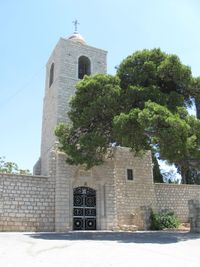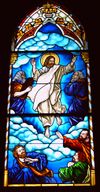Transfiguration of Jesus
| Major events in Jesus' life from the Gospels |
|---|
|

The Transfiguration of Jesus is an event reported by the Synoptic Gospels in which Jesus is transfigured upon a mountain (the Mount of Transfiguration) (Matthew 17:1-9, Mark 9:2-8, Luke 9:28-36). Jesus became radiant, spoke with Moses and Elijah, and was called "Son" by God. It is one of the miracles of Jesus mentioned in the Gospels.[1][2][3]
This miracle is unique among others that appear in the Gospels, in that the miracle happens to Jesus himself.[4] Thomas Aquinas considered the Transfiguration "the greatest miracle" in that it complemented baptism and showed the perfection of life in Heaven.[5]
According to the Gospels, Peter, James, son of Zebedee and John the Apostle were with Jesus upon the mountain. The transfiguration put Jesus above Moses and Elijah, the two preeminent figures of Judaism. It also supports his identity as the Son of God. In keeping with the Messianic Secret, Jesus tells the witnesses not to tell others what they saw until he has risen on the third day after his death on the cross.
The principal account is that in the Synoptic Gospels; Second Epistle of Peter and the Gospel of John may also briefly allude to the event (2 Peter 1:16-18, John 1:14). Peter describes himself as an eyewitness "of his sovereign majesty." None of the accounts identifies the "high mountain" of the scene by name. Since the 3rd century, some Christians have identified Mount Tabor as the site of the Transfiguration.[6] R. T. France notes that Mount Hermon is closest to Caesarea Philippi, mentioned in the previous chapter of Matthew.
Contents |
Interpretation of the passage
| “ | This is my Son, the Beloved; with him I am well pleased; listen to him! – Matthew 17:5 | ” |
In the narrative, after the voice speaks, Elijah and Moses have disappeared, and Jesus and the three apostles head down the mountain, Jesus telling his apostles to keep the event a secret until the "Son of Man" had risen from the dead. The apostles are described as questioning among themselves as to what Jesus meant by "risen from the dead" (Mark 9:9-10). The apostles are also described as questioning Jesus about Elijah, and he as responding "Elijah is indeed coming and will restore all things; but I tell you that Elijah has already come […]" (Mark 9:12-13). It was commonly believed that Elijah would reappear before the coming of the Messiah, as predicted in the Book of Malachi (Malachi 4), and the three apostles are described as interpreting Jesus' statement as a reference to John the Baptist (Matthew 17:13).
Symbolic readings take Moses and Elijah to represent the Law and the Prophets respectively, and their recognition of and conversation with Jesus symbolize how Jesus fulfils "the law and the prophets" (Matthew 5:17-19, see also Expounding of the Law).
Maximus the Confessor said that the senses of the apostles were likewise transfigured to enable them to perceive the true glory of Christ.[7]
Feast and commemorations

In the Syriac Orthodox, Indian Orthodox, Revised Julian Calendars within Eastern Orthodoxy, Roman Catholic, and Anglican churches, the Feast of the Transfiguration is observed on 6 August. In those Orthodox churches which continue to follow the Julian Calendar, August 6 falls on August 19 of the Gregorian Calendar. Transfiguration is considered a major feast, numbered among the twelve Great Feasts in Orthodoxy. In all these churches, if the feast falls on a Sunday, its liturgy is not combined with the Sunday liturgy, but completely replaces it.
In some liturgical calendars (e.g. the Lutheran and United Methodist) the last Sunday in the Epiphany season (that immediately preceding Ash Wednesday) is also devoted to this event. In the Church of Sweden and the Church of Finland, however, the Feast is celebrated on the seventh Sunday after Trinity, the eighth Sunday after Pentecost.
Eastern Orthodox practices

In the Eastern Orthodox Church, the Transfiguration falls during the Dormition Fast, but in recognition of the feast the fast is relaxed somewhat and the consumption of fish, wine and oil is allowed on this day.
In the Orthodox view the Transfiguration is not only a feast in honor of Jesus, but a feast of the Holy Trinity, for all three Persons of the Trinity are interpreted as being present at that moment: God the Father spoke from heaven; God the Son was the one being transfigured, and God the Holy Spirit was present in the form of a cloud. In this sense, the transfiguration is also considered the "Small Epiphany" (the "Great Epiphany" being the Baptism of Jesus, when the Holy Trinity appeared in a similar pattern).
The Tranfiguration is ranked as one of the Twelve Great Feasts of the Orthodox liturgical calendar, and is celebrated with an All-Night Vigil beginning on the eve of the Feast.
Grapes are traditionally brought to church to be blessed after the Divine Liturgy on the day of the Transfiguration. If grapes are not available in the area, apples or some other fruit may be brought. This begins the "Blessing of First Fruits" for the year.
The Transfiguration is the second of the "Three Feasts of the Saviour in August", the other two being the Procession of the Cross on August 1 and the Icon of Christ Not Made by Hand on August 16. The Transfiguration is preceded by a one-day Forefeast and is followed by an Afterfeast of eight days, ending the day before the Forefeast of the Dormition.
Roman Catholic church
In the Roman Catholic Church, the Transfiguration was once celebrated locally in various parts of the Catholic world on different days, including August 6, but was not universally recognized. In 1456, the Kingdom of Hungary repulsed an Ottoman invasion of the Balkans by breaking the Siege of Belgrade. News of the victory arrived in Rome on August 6.[8] Given the importance to international politics at that time of such battles between Christian and Muslim nations, in celebration of the victory Pope Callixtus III elevated the Transfiguration to a Feast day to be celebrated in the entire Roman rite.
In 2002, Pope John Paul II selected the Transfiguration as one of the five Luminous Mysteries of the rosary.
See also
- Tabor Light
- Buhe
References
- ↑ Clowes, John, 1817, The Miracles of Jesus Christ published by J. Gleave, Manchester, UK page 167
- ↑ Henry Rutter, Evangelical harmony Keating and Brown, London 1803. page 450
- ↑ Lockyer, Herbert, 1988 All the Miracles of the Bible ISBN 0310281016 page 213
- ↑ Karl Barth Church dogmatics ISBN 0567050890 page 478
- ↑ Nicholas M. Healy, 2003 Thomas Aquinas: theologian of the Christian life ISBN page 100
- ↑ Meistermann, Barnabas (1912), "Transfiguration", The Catholic Encyclopedia, XV, New York: Robert Appleton Company, http://www.newadvent.org/cathen/15019a.htm, retrieved 2007-08-15, citing Origen's Comm. in Ps. 88, 13
- ↑ Rossi, Vincent. "Orthodoxy & Creation: The Transfiguration of Creation". The Orthodox Fellowship of the Transfiguration. http://www.orth-transfiguration.org/library/orthodoxy/transfiguration/. Retrieved 2010-08-06.
- ↑ Kitchin, Rev. William P. H., Ph.D. (April 1916). "Priests as Soldiers". The American Ecclesiastical Review; a monthly publication for the clergy (Philadelphia: The Dolphin Press) 54 (4): 431. http://books.google.com/books?id=JdXNAAAAMAAJ.
External links
- "The Transfiguration of Our Lord", Butler's Lives of the Saints
- Catholic Encyclopedia: Transfiguration
- The Mountain of the Transfiguration by Michele Piccirillo
- Pope Benedict XVI on Transfiguration of Jesus
- The Holy Transfiguration of our Lord God and Savior Jesus Christ Orthodox icon and synaxarion
|
||||||||||||||||||||
|
Transfiguration of Jesus
Life of Jesus: Miracles
|
||
| Preceded by Peter's Confession of Christ Ministry of Jesus |
New Testament Events |
Succeeded by Parable of the Unmerciful Servant Parables of Jesus |


